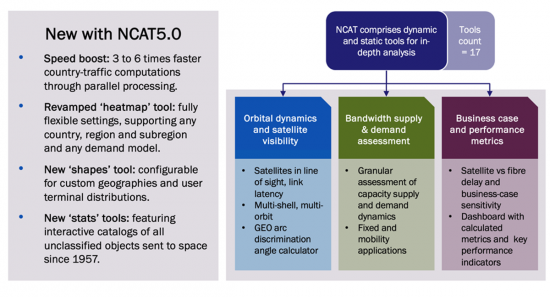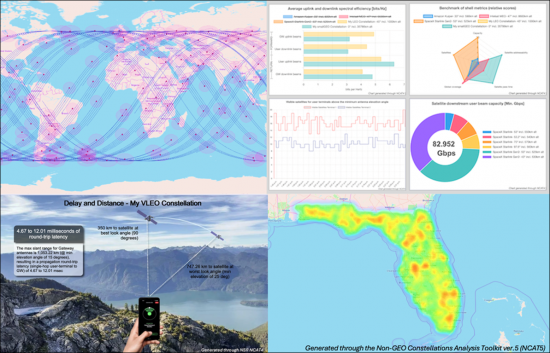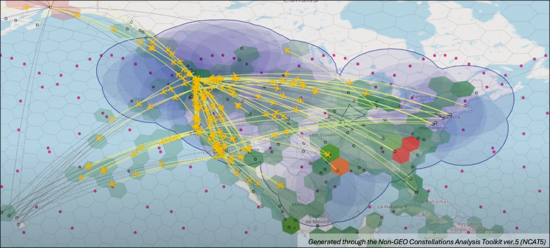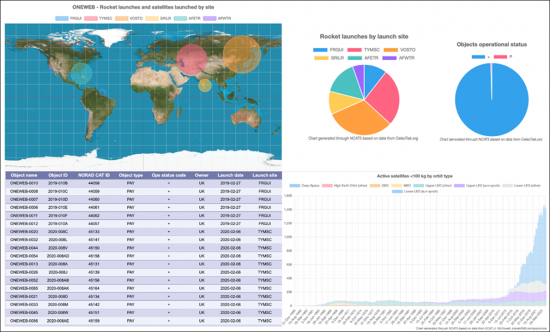|
年间契约型资讯服务
商品编码
1568193
非GEO卫星群分析工具包5.0Non-GEO Constellations Analysis Toolkit 5.0 |
|||||||
非 GEO 卫星群分析工具包(NCAT)结合了资料集、分析和互动式视觉化,以评估 LEO(低地球轨道)和 MEO(中地球轨道)卫星卫星群的实际性能。

战略家、商业和技术专业人士可以使用 NCAT 平台来分析 NGSO 卫星卫星群的性能及其对国家和地区的影响。
新发布的NCAT v5.0(NCAT5)以线上 Web 应用程式形式提供,提供了增强的工具,可用于细粒度评估频宽供应和需求趋势、市场准备和业务案例敏感性。也引进了新的指标来比较地面网路和卫星群的竞争格局。
工具包的范围
NCAT5 利用超过 60,000 行原始程式码和200万行可查询资料库来提供对卫星群效能指标和功能的公正评估。使用易于使用且可设定的工具(使用筛选器、视觉化控制项和使用者输入)动态计算数百万次计算。

本报告的主要特点:
- 正确编码的演算法:推动基于事实的分析和视觉化。
- 综合资料库:增强的更新周期使用户能够轻鬆运行新的模拟。
- 每日更新:在轨卫星数量(Starlink、SES mPOWER、OneWeb 等)和轨道观测结果每天自动更新。
- 每週更新:新的统计工具利用每週自动更新的广泛卫星目录。
- 季更新:核心软体和资料库增强功能每季实施一次。
- 点击式互动:透过互动式地图和控制项(图层、筛选器、按钮、设定),使用者可以放大和缩小,并点击以定位其装置。
- 多轨道、多频段分析:可针对一个或多个系统的外壳组合进行配置,同时对数千颗卫星进行计算。
- 动态动画视觉化:传播条件的即时视觉化,包括卫星位置、足迹、可见光卫星、天线视角、链路延迟变化、供应和需求热图。
- 时间/空间控制:NCAT5 可实现全球、区域和本地的即时分析和高速延迟分析。
- 模拟速度最高可提高 300 倍,工具包使用者可以在大约 5 分钟内运行一天的卫星群功能。
- 六角形地面网格:NCAT5 使用动态六角形网格,其国家级精度可达到城市规模(小区半径高达 9 公里)。
- 新的 "形状" 工具可定义除 NCAT 资料库中 258个预设国家/地区之外的任何地区。
- 增强的吞吐量计算:同时计算所有用户的链路预算吞吐量分析以及网关和用户终端视角任意组合的网关波束。
- 完全灵活的需求模型:NCAT5允许使用者从多种预设标准中进行选择并定义客户需求驱动因素(使用者终端分布、驱动频宽需求运算的能力等)。
- 需求驱动的供应:透过可选择的供应公平标准,NCAT 可以模拟可操纵波束能量重新配置,以符合不断变化的需求条件。
- 行动工具:NCAT 伺服器连结到商业航班资讯来源并评估 IFC(机上连线)供需趋势(数万条航线、航空公司和机场)。
- 统计:NCAT5 引进了两种新的统计工具,可处理自 1957年以来发射到太空的61,000 多个未分类物体的目录。
- 可下载的图表和资料:所有图表、地图和资讯图表都可以 PDF/PNG 格式下载。输出资料可以以表格 CSV 格式下载,以便在平台外进一步处理。
- 表格、图表资料、基准指标、带有时间戳记的样本、包含供需资料的地面网格、评估摘要、飞行路线、视角统计资料、光束利用率等。
- 多轨道、多频段分析:可针对一个或多个系统的外壳组合进行配置,同时对数千颗卫星进行计算。
使用面积 |
NCAT 致力于卫星通讯(satcom),但也包括评估地球观测(EO)和全球导航卫星系统(GNSS)的能力。 |
工具 |
易于使用且可设定的17种工具可实现多方面的分析和基准测试,包括:
|
卫星群壳 |
预先配置了90多个营运、规划、应用系统(使用者可以自行编辑和扩充) |
网关 |
超过 370个研究位置(可自行编辑和扩展) |
勘察目标区 |
258国家/地区/次区域已预先设定(使用者可自行编辑/扩充) |

本报告中回答的问题
- 如何在多个层面(包括覆盖范围/容量、波束和卫星)对目前和未来的NGSO 架构进行基准测试?
- 每个网关/用户波束、卫星和子卫星群的前向/反向连结容量(频率、频宽、IP 吞吐量)是多少?
- 如何估算可用资本成本(每 Mbps)?
- 业务案例对卫星製造和发射成本的各个要素的反应程度如何?
- 在什么条件下,在尚未提供连线服务的地区,卫星通讯卫星群将比光纤更具竞争力?
- Babak Hall 的业务案例对资本投资和营运成本有多敏感?
- 如何根据可调整的行动/固定宽频服务计画实际评估频宽的需求和供应?拥挤的区域在哪里? 它们会随着时间的推移而如何变化?
- 在所有纬度以及每种外壳/外壳组合的 "视线内" 或视距(LoS)卫星的最大、平均和最小数量是多少?
- 光纤延迟与 LEO 系统和拓扑相比如何?对POP、OISL(光学星间连结)、连结中继等的使用是否会产生影响?
- NGSO 系统避免干扰 GEO(GSO)系统的监管豁免角度是什么?

谁可以使用此工具箱:
- 现有/新卫星营运商(GSO 和 NGSO、FSS 和 MSS/D2D)
- 太空船製造商和零件供应商
- 地面和无线网路营运商:包括电信公司、行动网路营运商、铁塔营运商、有线营运商、IP 传输、WLL 和云端服务供应商)
- 地面系统供应商(终端、MSA/ESA 天线、集线器/数据机、SD-WAN、地面网路虚拟化)
- 电信业者、卫星服务供应商、NGSO 託管服务的整合商和经销商
- NGSO 容量的主要用户,包括政府、国防和商业最终用户(航空公司、邮轮公司、能源公司等)
- 产业组织、研究机构、研究机构
- 为卫星群开发虚拟化云端软体解决方案的IT 公司
- 监管机构与频率研究机构
- 金融机构、投资管理、保险
包含卫星系统(范例)
Amazon Project Kuiper、AST SpaceMobile、Boeing、E-Space、G60 SailSpace、GW-2、GW-A59、Hughes、Inmarsat Orchestra、Intelsat MEO、Iridium、Kepler、Lynk Global、Mangata Networks、Omnispace、OneWeb、Rivada、SES mPOWER &O3b、SpaceX Starlink、Telesat Lighspeed、ViaSat。
NCAT 作为线上、可设定的工具集具有无限的可用性,并预先填充了主要 NGSO 系统(包括已批准的、运营的和提议的系统)的资料集。
市场评论
"出色的工具集!灵活、可视化、易于使用并可进行深入分析" - Pablo Rasore,CEO、Grupo Andesat
The Non-GEO Constellations Analysis Toolkit (NCAT) fuses datasets, analytics and interactive visualisations into factual performance assessments of LEO and MEO satellite constellations.

Strategists, business and technical professionals alike leverage the NCAT platform to analyse the capabilities of NGSO constellations and their impact in any country or region.
Delivered as an online WebApp, the newly released NCAT v5.0 (NCAT5) includes enhanced tools for granular assessments of bandwidth supply and demand dynamics, market addressability and business case sensitivity. It also introduces new metrics and compares the competitive standing of constellations with that of terrestrial networks.
Toolkit coverage
NCAT5 leverages over 60 thousand lines of original code and 2 million query-able database rows to drive unbiased assessments of constellations' performance metrics and capabilities. Millions of calculations are computed dynamically through tools that are easy to use and configurable though filters, visualisation controls and user inputs.

Features include:
- Rigorously coded algorithms: driving factual analytics and visualisations.
- Comprehensive database: with enhanced update cycles for users to run fresh simulations effortlessly.
- Daily updates: the number of in-orbit satellites (Starlink, SES mPOWER, OneWeb, etc.) and their orbital observations are updated daily and automatically.
- Weekly updates: the new statistics tools leverage extensive satellite catalogues updated weekly and automatically.
- Quarterly updates: enhancements to the core software and database are deployed quarterly.
- Point-and-click interactivity: through interactive maps and controls (layers, filters, buttons and settings) users zoom in/out, click to set user-terminal locations and control dynamic calculations and visualisations.
- Multi-orbit, multi-band analysis: simulations are configurable for combinations of shells from one or multiple systems, driving calculations concurrently for thousands of satellites.
- Dynamic, animated visualisations: users visualise propagating conditions in real time including satellites position, footprint, visible satellites, antenna look angles, link latency variations, supply and demand heatmaps, etc.
- Space-time controls: NCAT5 allows real-time and accelerated time-lapse analysis globally, regionally or locally.
- Simulations can be accelerated up to 300 times, allowing toolkit users to run an entire day of constellation performance in around 5 minutes.
- Hexagonal ground grid: NCAT5 uses a dynamic hex-grid with country-level precision configurable down to city-size resolution (~9 km cell radius).
- The new 'shapes' tool allows users to define any geography beyond the 258 countries and regions preset in the NCAT database.
- Boosted IP throughput computations:computes link-budget throughput analysis concurrently on all user and gateway beams for combinations of gateway and user-terminal look angles.
- Fully flexible demand models: NCAT5 allows users to select from different pre-set criteria or define custom demand factors, including the distribution of user terminals and functions driving the bandwidth demand calculations.
- Demand-driven supply: via selectable supply fairness criteria, NCAT simulates reconfigurations of steerable beam capacity to meet changing demand conditions.
- Mobility tool: the NCAT server is linked to sources of commercial flights information for the assessment of in-flight connectivity (IFC) supply/demand dynamics (tens of thousands of flight routes, airlines and airports).
- Statistics: NCAT5 introduced two new statistics tools that interact with catalogues of over 61 thousand unclassified objects launched to space since 1957.
- Downloadable charts and data: all charts, maps and infographics are downloadable in PDF/PNG format. The output data is downloadable in tabular CSV format to allow further processing outside the platform.
- Tables, charts data, benchmark metrics, time-stamped samples, terrestrial grids with supply and demand data, assessment summaries, flight routes, look angle stats, beam utilisation, etc.
Applications |
NCAT is focused on satellite communications (satcom) but includes features to assess earth observation (EO) and global navigation satellite systems (GNSS). |
Tools |
17 easy-to-use, configurable tools to analyse and benchmark systems from multiple angles, including:
|
Constellation shells |
90+ operational and planned or filed systems preset (user editable and expandable) |
Gateways |
370+ surveyed locations (user editable and expandable) |
Geographical regions |
258 countries, territories, regions and subregions preset (user editable and expandable) |

Questions answered:
- How does current and future NGSO architecture benchmark at multiple layers including coverage, capacity, beams and satellites?
- What is the forward and return link capacity (spectrum, bandwidth and IP throughput) per gateway/user beam, satellite and sub-constellation?
- How can the capital cost per usable Mbps be inferred?
- What is the business-case sensitivity to satellite manufacture and launch cost elements?
- Under what conditions can satcom constellations become more competitive than fiber optics to target underserved communities?
- How sensitive is the backhaul business case to capex and opex?
- How to assess bandwidth supply and demand factually, based on configurable mobility and fixed broadband service plans? Where are the congestion areas and how do they shift over time?
- What is the maximum, average and minimum number of satellites 'in view' or line of sight (LoS) across all latitudes, per shell and combination of shells?
- How does fibre latency benchmark against LEO systems and topologies, depending on POPs, use of optical inter-satellite links (OISL) and link relays?
- What are the regulatory exclusion angles for NGSO systems to avoid interfering with GEO (GSO) systems?

Who should use this toolbox:
- Established and emerging satellite operators (GSO & NGSO, FSS & MSS /D2D)
- Spacecraft manufacturers and component vendors
- Terrestrial and wireless network operators including telcos, MNOs, towercos, cable operators, IP transit, WLL and cloud service providers
- Ground system vendors (terminals, MSA/ESA antennas, hub/modems, SD-WAN, ground-network virtualisation)
- Teleport operators, satellite service providers, integrators and distributors of NGSO managed services
- Major users of NGSO capacity including government, defence and commercial end users (for example, airlines, cruise lines, energy players)
- Industry associations, research labs and institutions
- IT companies that are developing virtualised cloud software solutions for constellations
- Regulators and spectrum research agencies
- Financial institutions, investment management and insurance.
Satellite systems included (examples)
Amazon Project Kuiper, AST SpaceMobile, Boeing, E-Space, G60 SailSpace, GW-2, GW-A59, Hughes, Inmarsat Orchestra, Intelsat MEO, Iridium, Kepler, Lynk Global, Mangata Networks, Omnispace, OneWeb, Rivada, SES mPOWER & O3b, SpaceX Starlink, Telesat Lighspeed, ViaSat.
As an online configurable toolset NCAT has unlimited usability and is delivered pre-populated with datasets for leading NGSO systems, including granted, operating and proposed systems.
Market commentary:
"The go-to compendium and toolkit for NGSO constellations." - Konrad Nieradka, System and Service Architect - Rivada Space Networks.
"Very impressive piece of work, and incredibly useful." - Nihar Shah, Vice President, Strategy and Market Intelligence - SES.
"Excellent toolset! Flexible, visual, easy-to-use and with in-depth analysis." - Pablo Rasore, CEO - Grupo Andesat.





